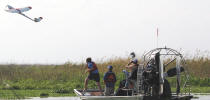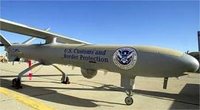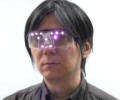Wireless Drones Overhead... Get Used to Them |
|
1 | 2 | 3 | 4 | 5 | 6 | 7 | 8 | 9 | 10 | 11 | 12 | 13 | 14 | 15 | 16 | 17 | 18 | 19 | 20 | 21 | 22 | 23 | 24 | 25 | 26 | 27 | 28 | 29 | 30 | 31 | 32 | 33 | 34 | 35 | 36 | 37 The drone, aka Remotely Piloted Vehicle (RPV) and Unmanned Aerial System (UAS), has been mainstreamed in the last few years. Although drones have been around since the end of World War I, in use for target practice and eventually for reconnaissance, they have evolved from fairly crude platforms that require intensive human interaction to fully autonomous systems that can be programmed with a full mission profile then launched, modified for mission changes en route and in situ if necessary, and finally retrieved and reused. GPS, inertial guidance (gyroscopes), radar, lidar, and other complex sensors allow the craft to monitor and correct its flight course and attitude. For many dangerous missions - especially highly dangerous ones - drones have virtually eliminated the need to have a human pilot in the cockpit. The USAF envisioned decades ago that this would be the case, and further sees the day when even dogfights (aka air-to-air combat) will be conducted between drones of opposing militaries. I remember reading futuristic articles on such scenarios in publications like Popular Science as a teenager back in the 1970s. Today, a third of all aircraft in the U.S. military's inventory are drones.
Similar to how GPS (Global Positioning System) gained widespread popularity and adoption during the Desert Storm era in the early 1990s, airborne drones, aka UAVs (Unmanned Aerial Vehicles), have become ubiquitous in society as well as in the military. Model aircraft hobbyists and professional engineering teams - often one and the same - have advanced the state of the art in all aspects of miniature aircraft including electric motor and rechargeable battery propulsion; radio control system miniaturization, range, and reliability; aerodynamics and airframe materials and constructions techniques; sensors for position, attitude, and surveillance (cameras, sonar, radar, thermal); and autonomous, intelligent flight. That goes for both fixed wing (conventional airplane) and rotating wing (helicopter and quad-rotor) aircraft. Even miniature sounding rockets are seeing increased use by private concerns. With complete systems being built so cheaply in China, the average person with no prior experience in operating a model aircraft of any type can buy a fully stabilized quadrotor platform complete with a video camera and a wireless link to allow the operator to send the beast to areas where it is out of visual sight for true remote piloting. Of course the more skilled you are at operating the craft, the more success you are likely to have. Weather still plays an important role in that success since most aircraft available to anyone other than the military are very lightweight and cannot fly in winds greater than about 15 mph or in heavy precipitation. The Department of Homeland Security (DHS) has been using drones to patrol America's southern border for many years - just a little longer than private landowners have been using cheaper versions to monitor Homeland Security's activity along the border. Police departments have begun obtaining permission from the Federal Aviation Administration (FAA) and local authorities to fly sorties over crowds during large gatherings, in areas of suspected crime activity, to look for marijuana fields, and in future mission testing investigations. Reports have surfaced documenting other governmental agencies using drones to fly over private property for monitoring potential water runoff violations, herd and crop health, property inventory, and other purposes. The Federal Government owns and regulates all of the airspace over your head and, technically, the air that you breathe (unless you're underground or on supplemental oxygen). As this article is being written, the FAA is integrating UAS (Unmanned Aircraft Systems) operation into its massive tomes of legalese known as the Federal Aviation Regulations (FARs). The Department of Homeland Security (DHS) of course is involved in the process since it and many other infamous three-letter government agencies are the main users of UAV/UAS platforms. FPV model airplane flying around Brooklyn. As one commenter posted, "That was neat. I wonder how many federal laws were just broken. Between DHS, the FAA and the FCC I can only imagine." This R/C MQ-9 Reaper is available almost ready to fly. It has a turret-mounted camera. First-Person-View (FPV) model demonstration. These days every specialty group has an official organization (or two or three), and so it is with the Association for Unmanned Vehicle Systems International (AUVSI). According to an article in the January 2013 edition of Air & Space magazine (a Smithsonian Institution publication) titled "Drones for Hire," AUVSI's first industry trade show in 1973 drew only a handful of exhibitors. The 2012 show had 572. Once the exclusive realm of government agencies because of their high prices, RPVs with wireless cameras and remote controls (all operating in the unlicensed 2.4 GHz ISM band) can now be purchased from hobby outlets for a few hundred dollars. Long-range surveillance is possible with the aid of controversial First Person View (FPV) systems where Joe Sixpack can fly his R/C model beyond visual range with the help of an onboard camera, GPS position reporting, and autopilot features that keep the platform in the air at a programmable altitude. Commercial systems can cost many thousands of dollars, but are still very "affordable" compared to prices just a decade ago. Just as amateur radio operators have contributed mightily to the state of the art in radio communications and amateur astronomers have helped advance the science of planetary, solar and deep space research, so have aircraft modelers leant their collective knowledge to help design and refine unmanned aerial vehicles. Every step of the way, the FAA (and recently DHS) has attempted to bring all operations under the purview of their long and strong arms of control. The Academy of Model Aeronautics (AMA), America's oldest and most active private organization for aeromodelers, is working with the FAA to formulate mutually agreeable regulations under which citizens may own and operate radio controlled (R/C) model aircraft. As you might imagine, the process has been arduous and frustrating. Bureaucrats who have no idea what model aviation is all about were originally assigned to represent the government's interest, but over the two or three years since the process began the relationship has gradually improved and a few agents who are themselves aircraft modelers have become part of the negotiations. Release of the final law is due in the Spring of 2013. We in the aeromodeling world have our fingers crossed. The situation was bad enough just keeping the government from requiring licensing of all R/C operators and operations (not out of the woods on that one yet), but lately a plethora of First-Person-View (FPV) models entering the marketplace through hobby distributors has multiplied the headache quotient considerably. Videos are appearing on YouTube of people - usually not AMA members - flying their models into restricted areas like around the Statue of Liberty, over train stations and museums, through open-structured buildings and landmarks, and even buzzing animals and humans (some of whom are indistinguishable from animals). Cameras recording the videos are mounted on the airplane, helicopter, or quadrotor, and to make matters worse, some are flying under FPV control. The AMA strictly prohibits any member from flying in FPV mode without a companion by his side that can maintain visual contact with the vehicle to advise and/or assume control if necessary. AMA officers and lawyers are losing sleep and getting ulcers over this activity.
Here is a video recorded by a camera rubber-banded to the side of my R/C Taylorcraft airplane. (a clear and present danger to the myself and anyone around me) - Kirt Blattenberger
Posted October 15, 2021 |

 "
" No longer the exclusive realm of militaries,
drones have permeated society in various and sundry roles for domestic and law enforcement
surveillance, for scientific and corporate exploration, and for hobby pursuits.
They have gone from the battlefield to the farm field. Many people are not comfortable
with the thought of pilotless aircraft flying over their persons and property both
from a safety standpoint and from a privacy standpoint, especially when the remote
pilots rely totally on a camera and GPS coordinates to control the aircraft because
it is often far away from the pilot's location. I share the concern for both reasons.
Aside from not desiring to be watched by an electromechanical Orwellian Big Brother
(I have no confidence that only well-intentioned users will be snooping on American
citizens in order to keep us safe, and I have never bought into the argument that
if I'm not doing anything wrong then I shouldn't care if I 'm being watched), I
have seen enough radio controlled aircraft (including a few of my own) experience
an unplanned meeting with terra firma to give credibility to the safety hazard worry
caused when masses are hurtling through the air with tiny buzz saws (propellers)
spinning at high rpms. It is only a matter of time before a drone falls out of the
sky and harms or kills someone.
No longer the exclusive realm of militaries,
drones have permeated society in various and sundry roles for domestic and law enforcement
surveillance, for scientific and corporate exploration, and for hobby pursuits.
They have gone from the battlefield to the farm field. Many people are not comfortable
with the thought of pilotless aircraft flying over their persons and property both
from a safety standpoint and from a privacy standpoint, especially when the remote
pilots rely totally on a camera and GPS coordinates to control the aircraft because
it is often far away from the pilot's location. I share the concern for both reasons.
Aside from not desiring to be watched by an electromechanical Orwellian Big Brother
(I have no confidence that only well-intentioned users will be snooping on American
citizens in order to keep us safe, and I have never bought into the argument that
if I'm not doing anything wrong then I shouldn't care if I 'm being watched), I
have seen enough radio controlled aircraft (including a few of my own) experience
an unplanned meeting with terra firma to give credibility to the safety hazard worry
caused when masses are hurtling through the air with tiny buzz saws (propellers)
spinning at high rpms. It is only a matter of time before a drone falls out of the
sky and harms or kills someone.